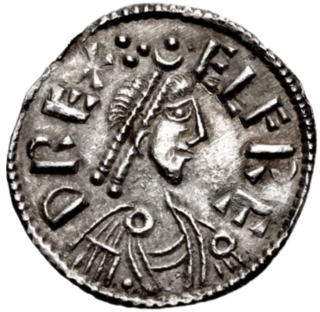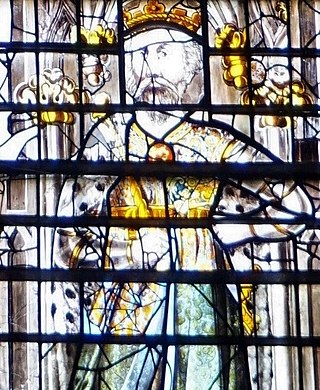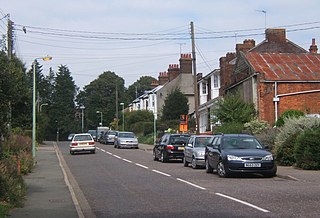Background
In 866, the Great Heathen Army landed in East Anglia with the intention of conquering all of the English kingdoms. During its campaign, the Viking army conquered the kingdoms of East Anglia, Mercia, and Northumbria. It initially overran the Kingdom of Wessex, but Danish King Guthrum was defeated by Alfred's army at the Battle of Edington in 878. Under the terms of his surrender, shortly afterward, Guthrum was obliged to be baptised [lower-alpha 1] to endorse the agreement, as well as to allow him to rule more legitimately over his Christian vassals but remaining pagan to his pagan vassals. He was then with his army to leave Wessex. That agreement is known as the Treaty of Wedmore.
Sometime [lower-alpha 2] after Wedmore, a treaty was agreed that set out the lasting peace terms between the two kings, which is known as the Treaty of Alfred and Guthrum. The treaty is one of the few existing documents [lower-alpha 3] of Alfred's reign and survives in Old English in Corpus Christi College, Cambridge, Manuscript 383, and in a Latin compilation, known as Quadripartitus .
The year that the treaty was created is not known for sure, but is believed to have been between 878 [lower-alpha 2] and Guthrum's death in 890.
The prologue to the treaty was a legitimisation of the territory that was held by both parties: Guthrum's landholdings in East Anglia and Alfred's in Mercia. Clauses 2 and 3 specify the blood money (or weregild), that is the value of men based on their status. The other clauses are concerned with the purchase of men, horses and oxen. There is also provision for hostages as a guarantee of good faith for one side trading with the other.

Alfred the Great was King of the West Saxons from 871 to 886, and King of the Anglo-Saxons from 886 until his death in 899. He was the youngest son of King Æthelwulf and his first wife Osburh, who both died when Alfred was young. Three of Alfred's brothers, Æthelbald, Æthelberht and Æthelred, reigned in turn before him. Under Alfred's rule, considerable administrative and military reforms were introduced, prompting lasting change in England.

Æthelred I was King of Wessex from 865 until his death in 871. He was the fourth of five sons of King Æthelwulf of Wessex, four of whom in turn became king. Æthelred succeeded his elder brother Æthelberht and was followed by his youngest brother, Alfred the Great. Æthelred had two sons, Æthelhelm and Æthelwold, who were passed over for the kingship on their father's death because they were still infants. Alfred was succeeded by his son, Edward the Elder, and Æthelwold unsuccessfully disputed the throne with him.

The Danelaw was the part of England in which the laws of the Danes held sway and dominated those of the Anglo-Saxons. The Danelaw contrasts with the West Saxon law and the Mercian law. The term is first recorded in the early 11th century as Dena lage. The areas that constituted the Danelaw lie in northern and eastern England, long occupied by Danes and other Norsemen.

Ine or Ini, was King of Wessex from 689 to 726. At Ine's accession, his kingdom dominated much of what is now southern England. However, he was unable to retain the territorial gains of his predecessor, Cædwalla, who had expanded West Saxon territory substantially. By the end of Ine's reign, the kingdoms of Kent, Sussex, and Essex were no longer under West Saxon sway; however, Ine maintained control of what is now Hampshire, and consolidated and extended Wessex's territory in the western peninsula.
Guthrum was King of East Anglia in the late 9th century. Originally a native of Denmark, he was one of the leaders of the "Great Summer Army" that arrived in Reading during April 871 to join forces with the Great Heathen Army, whose intentions were to conquer the kingdoms of Anglo-Saxon England. The combined armies were successful in conquering the kingdoms of East Anglia, Northumbria, and parts of Mercia, and overran Alfred the Great's Wessex, but were ultimately defeated by Alfred at the Battle of Edington in 878. The Danes retreated to their stronghold, where Alfred laid siege and eventually Guthrum surrendered.

At the Battle of Edington, an army of the kingdom of Wessex under Alfred the Great defeated the Great Heathen Army led by the Dane Guthrum on a date between 6 and 12 May 878, resulting in the Treaty of Wedmore later the same year. Primary sources locate the battle at "Eðandun". Until a scholarly consensus linked the battle site with the present-day village of Edington in Wiltshire, it was known as the Battle of Ethandun. This name continues to be used.

A fyrd was a type of early Anglo-Saxon army that was mobilised from freemen or paid men to defend their Shire's lords estate, or from selected representatives to join a royal expedition. Service in the fyrd was usually of short duration and participants were expected to provide their own arms and provisions.

Æthelwold or Æthelwald was the younger of two known sons of Æthelred I, King of Wessex from 865 to 871. Æthelwold and his brother Æthelhelm were still infants when their father the king died while fighting a Danish Viking invasion. The throne passed to the king's younger brother Alfred the Great, who carried on the war against the Vikings and won a crucial victory at the Battle of Edington in 878.
The Treaty of Wedmore is a 9th-century agreement between King Alfred the Great of Wessex and the Viking king, Guthrum the Old. The only contemporary reference to the treaty is that of a Welsh monk, Asser, in his biography of Alfred, known as Vita Ælfredi regis Angul Saxonum, or "The Life of King Alfred", in which Asser describes how after Guthrum's defeat at the Battle of Edington, followed by his surrender some days later, he agreed to a peace treaty with Alfred. The treaty was conditional on Guthrum's being baptised to endorse the agreement, as well as to allow him to rule more legitimately over his Christian vassals but to remain pagan to his pagan vassals. Also, Guthrum and his army were to leave Wessex.

The Great Heathen Army, also known as the Viking Great Army, was a coalition of Scandinavian warriors who invaded England in AD 865. Since the late 8th century, the Vikings had been engaging in raids on centres of wealth, such as monasteries. The Great Heathen Army was much larger and aimed to conquer and occupy the four kingdoms of East Anglia, Northumbria, Mercia and Wessex.

Ubba was a 9th-century Viking and one of the commanders of the Great Heathen Army that invaded Anglo-Saxon England in the 860s. The Great Army appears to have been a coalition of warbands drawn from Scandinavia, Ireland, the Irish Sea region and Continental Europe. There is reason to suspect that a proportion of the Viking forces specifically originated in Frisia, where some Viking commanders are known to have held fiefdoms on behalf of the Franks. Some sources describe Ubba as dux of the Frisians, which could be evidence that he also associated with a Frisian benefice.

Bagsecg, also known as Bacgsecg, was a viking and a leader of the Great Army, which invaded England. According to the Anglo-Saxon Chronicle, Bagsecg and Healfdene were joint commanders of the Great Army that invaded the Kingdom of Wessex during the northern winter of 870/71.

The Kingdom of the East Angles, informally known as the Kingdom of East Anglia, was a small independent kingdom of the Angles during the Anglo-Saxon period comprising what are now the English counties of Norfolk and Suffolk and perhaps the eastern part of the Fens, the area still known as East Anglia.
Guthrum II was, according to some reconstructions, a King of East Anglia in the early 10th century.
Events from the 9th century in England.

Shotley Gate is a settlement in the civil parish of Shotley, in the Babergh district, in the county of Suffolk, England. It is located at the tip of Shotley Peninsula and is the largest settlement in the parish of Shotley, in 2020 it had an estimated population of 1461. Shotley Gate has a pub called the Bristol Arms the settlement of Shotley Gate developed either side of Bristol Hill.

Viking activity in the British Isles occurred during the Early Middle Ages, the 8th to the 11th centuries CE, when Scandinavians travelled to the British Isles to raid, conquer, settle and trade. They are generally referred to as Vikings, but some scholars debate whether the term Viking represented all Scandinavian settlers or just those who used violence.
The Battle of Buttington was fought in 893 between a Viking army and an alliance of Anglo-Saxons and Welsh.

Wulfhere was Ealdorman for Wiltshire, when the Anglo-Saxon kingdoms, of England, were experiencing turbulent times. An invading Danish army had landed in East Anglia, in 865 and had conquered all of the English kingdoms apart from Wessex. The Danish king Guthrum was overrunning the kingdom of Wessex, with Alfred the king of Wessex in retreat. The county of Wiltshire was part of Wessex and on its northern border was Danish held Mercia. Wulfhere was left with a problem, should he stay loyal to his king (Alfred) or do a deal with the invader? The evidence from the charters of the time infer that Wulfhere had some sort of arrangement with Guthrum. So when Alfred was able to regain control of his kingdom Wulfhere was held to account.
The Battle of Chippenham was a January 878 battle between a Viking army led by Guthrum and an Anglo-Saxon army led by Alfred the Great. The Vikings forced Alfred to flee Chippenham and managed temporarily to gain control over most of Wessex.













